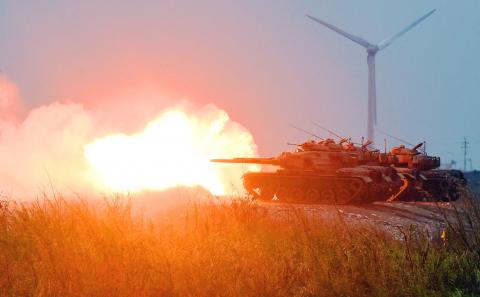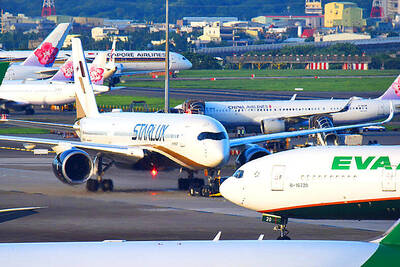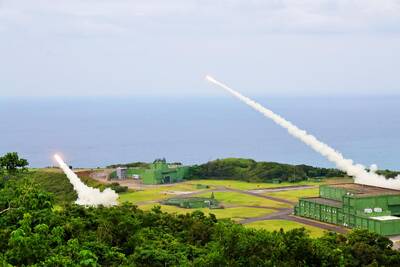The army is to upgrade its M60A3 Patton tanks as part of a five-year plan to build up its combat forces, army generals told Control Yuan President Chang Po-ya (張博雅) at a conference in Kinmen County on June 28.
The conference took place after Chang and members of the Control Yuan National Defense and Intelligence Committee toured an outpost guarded by the Lieyu Defense Team of the Kinmen Defense Command.
When questioned by committee members about the army’s tanks becoming obsolete, the generals told them the military is planning to upgrade its M60A3 tanks, although it has yet to decide the type of upgrades and the number of tanks to be upgraded.

Photo: Liao Chen-huei, Taipei Times
The program is in the early stages of conceptual planning, they said, adding that battle requirements would guide the military in identifying what improvements are needed for its tanks.
Although the Ministry of National Defense plans to buy 108 M1A2 Abrams tanks from the US and has tendered a letter of request to Washington, the bulk of the army’s armored units would continue to be equipped with legacy platforms after the service acquires new tanks.
The army’s frontline tank fleet consists of 480 M60A3s, 450 CM11s, or modified M48 turrets mated to M60 chassis, and 250 CM12s, or C11 turrets mated to M48 hulls, according to the Defense Industry Daily Web site.
The fundamental technology used in the tanks dates back to the 1940s and 1950s, and their 105mm rifled gun is mostly unable to cope with modern battle tanks, while their armor plating does not utilize composite materials used in modern armored fighting vehicles.
The army in 2017 expressed an interest in upgrading its M60A3 tanks with 120mm smoothbore guns, which have replaced 105mm guns in most Western armies, as well as new turrets, turret hydraulics and ballistics computers.
However, the project’s price tag of NT$100 million (US$3.21 million at the current exchange rate) per tank apparently put off top brass and it did not appear in the nation’s defense budget in the years since.

Trips for more than 100,000 international and domestic air travelers could be disrupted as China launches a military exercise around Taiwan today, Taiwan’s Civil Aviation Administration (CAA) said yesterday. The exercise could affect nearly 900 flights scheduled to enter the Taipei Flight Information Region (FIR) during the exercise window, it added. A notice issued by the Chinese Civil Aviation Administration showed there would be seven temporary zones around the Taiwan Strait which would be used for live-fire exercises, lasting from 8am to 6pm today. All aircraft are prohibited from entering during exercise, it says. Taipei FIR has 14 international air routes and

Taiwan lacks effective and cost-efficient armaments to intercept rockets, making the planned “T-Dome” interception system necessary, two experts said on Tuesday. The concerns were raised after China’s military fired two waves of rockets during live-fire drills around Taiwan on Tuesday, part of two-day exercises code-named “Justice Mission 2025.” The first wave involved 17 rockets launched at 9am from Pingtan in China’s Fujian Province, according to Lieutenant General Hsieh Jih-sheng (謝日升) of the Office of the Deputy Chief of the General Staff for Intelligence at the Ministry of National Defense. Those rockets landed 70 nautical miles (129.6km) northeast of Keelung without flying over Taiwan,

City buses in Taipei and New Taipei City, as well as the Taipei MRT, would on Saturday begin accepting QR code payments from five electronic payment providers, the Taipei Department of Transportation said yesterday. The new option would allow passengers to use the “transportation QR code” feature from EasyWallet, iPass Money, iCash Pay, Jkopay or PXPay Plus. Passengers should open their preferred electronic payment app, select the “transportation code” — not the regular payment code — unlock it, and scan the code at ticket readers or gates, General Planning Division Director-General Liu Kuo-chu (劉國著) said. People should move through the

The Ministry of National Defense (MND) today released images of the military tracking China’s People's Liberation Army (PLA) movements during the latest round of Chinese drills around Taiwan. The PLA began "Justice Mission 2025" drills today, carrying out live-fire drills, simulated strikes on land and maritime targets, and exercises to blockade the nation's main ports. The exercises are to continue tomorrow, with the PLA announcing sea and air space restrictions for five zones around Taiwan for 10 hours starting from 8:30am. The ministry today released images showing a Chinese J-16 fighter jet tracked by a F-16V Block 20 jet and the